
Featured Blog | This community-written post highlights the best of what the game industry has to offer. Read more like it on the Game Developer Blogs or learn how to Submit Your Own Blog Post
Narrative Design Tips I Wish I'd Known
Four Narrative Design principles that I wish I'd known when I first started.

I've been working on a video game writing curriculum for the Gotham Writers' Workshop for more than two months now, and it made me realize how much I wish I'd known when I first started.
So, in the spirit of creative amity, I decided to share a few tips for up and coming storytellers: the four things that I most wish I had known as a burgeoning writer and narrative designer. Hopefully they'll help you with your current project.
Tip #1: Story Starts With Gameplay
The most common mistake new game writers make (which I was guilty of when I first started) is they create a story that isn't related to the second-by-second gameplay. Essentially, they think of the most awesome story they can - concerning themselves more with awesomeness than the mechanics of the game - and then they slide it in between chunks of gameplay. The gameplay does its own thing, which often times has very little to do with the story other than "go kill this boss", and the writers pepper in some cutscenes when they feel the need to progress the plot.
Best case scenario, the game feels disjointed and choppy. Worst case, the gameplay and the story contradict each other to the point where the player can't take either seriously.
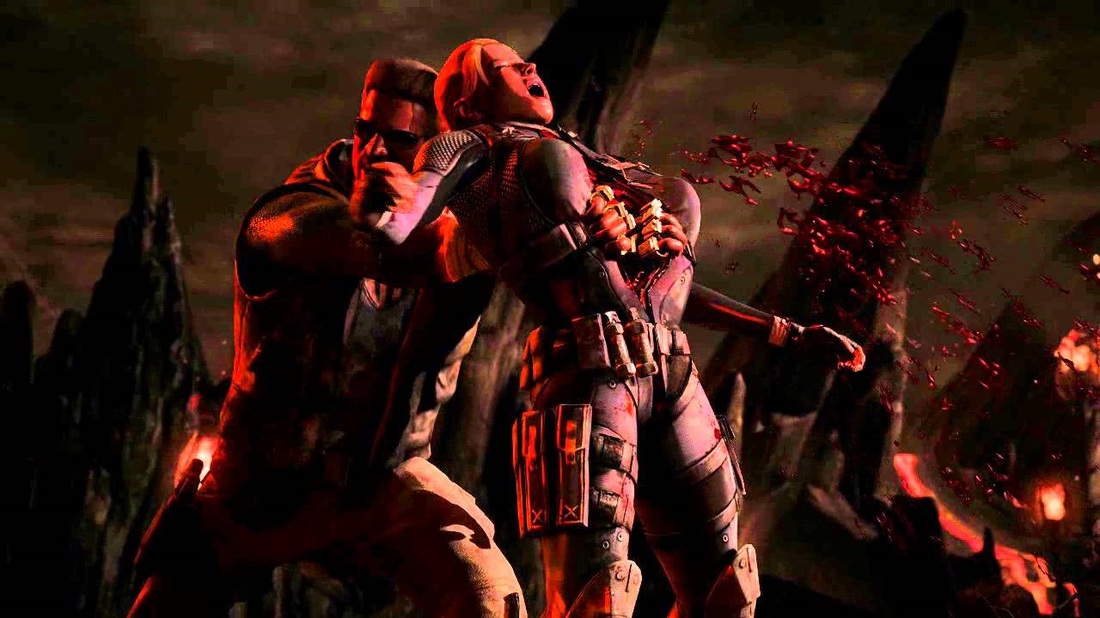
(Mortal Kombat X took a lot of heat for its story and gameplay mismatch. The cutscenes are about strong family ties, but the gameplay is about ripping holes in your daughter's torso)
That's why most professional game writers start by studying the gameplay - a process that I call "verbing". It's the writer's job to look at the gameplay and identify all of the different things a player can do. What are the verbs?
Can the player fight? How do they fight? Do they punch? Do they shoot? Can they die?
Can the player explore the world? Can they jump? Can they talk to NPCs? Open chests?
Can the player hide from an enemy? Can they talk their way out of a fight?
First and foremost, taking an account of all the different verbs in our game helps us understand our storytelling and design options. For example, if your character can die, respawning can become a part of the story, like it is in Dark Souls - the undead are connected to the first flame, and so the fact that the player "respawns" at the last bonfire they visited becomes part of the narrative. Verbing can also clue you into the limitations of your gameplay early on - if your player can't freely explore, like in most fighting games, you'll need to rely on cutscenes to move your characters from location to location.
But, even more important than discovering your design options, "verbing" is the first step towards making your gameplay mean something on an emotional level.
A story in a game isn't just there to be entertaining by itself: it's there to improve the gameplay. The goal is to make the gameplay not just fun, but emotionally compelling. Games are fun in and of themselves, and so are stories, but the goal of combining them together is to get the player to feel something about what they're doing.
There's more than one way to make emotionally compelling gameplay, but I like to start by viewing our list of verbs as the behavior of the avatar character. The player is controlling someone or something (or multiple someones or somethings) and that thing they control is taking these actions. I like to ask: What kind of person does these things? What kind of character participates in this kind of behavior? How does the gameplay give the player insight into who this character is?
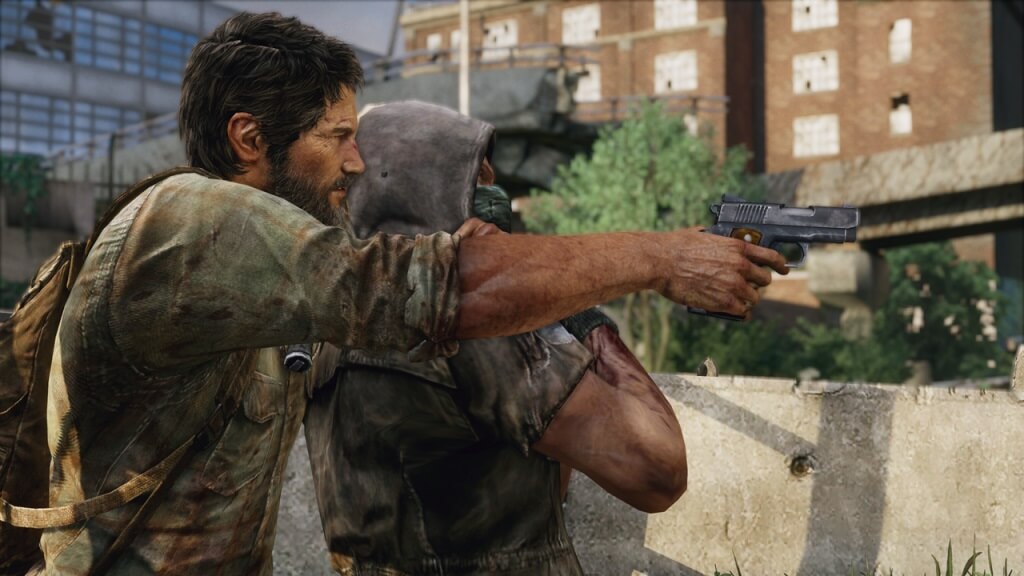
(In The Last of Us you're able to take hostages during gameplay. The writer's job is to ask: What kind of person takes hostages? What's a great story about someone willing to fight that dirty?)
The gameplay is how this character is choosing (or is forced) to accomplish their goals, which tells our player something about them. Our goal is to make that behavior a key element of our story. By using that character's behavior as our first building block, the gameplay actually becomes more entertaining because of the writing: because the gameplay is an insight into our main character, and because that insight is important, the player starts to care about the second-to-second gameplay on an emotional level.
The goal of a video game story is to work together with the gameplay to create something greater than the sum of its parts. The gameplay can help us tell the story by giving us insight into the avatar character, and the story can make the gameplay even more entertaining by getting the player emotionally invested. Like I said before, there's more than one way to make a great video game story - it doesn't have to be about the avatar character - but it should always start with what the player does.
Tip #2: The Story Isn't The Words
Another common mistake: beginners will often focus all of their storytelling skills on their cutscenes and their dialogue, but the words are only a part of the story. In fact, the story encompasses every single aspect of the game, from the writing, to the gameplay, to the environment art, to the enemy design, and on and on. Any and every aspect of the game is a vehicle for storytelling, and all of those different elements combined create the whole story. Using all of the different facets of a game to tell a story is actually a skill set referred to as "narrative design", and not all writers need to be narrative designers, but every writer should have a basic understanding of the principle. On paper, it looks a little something like this:
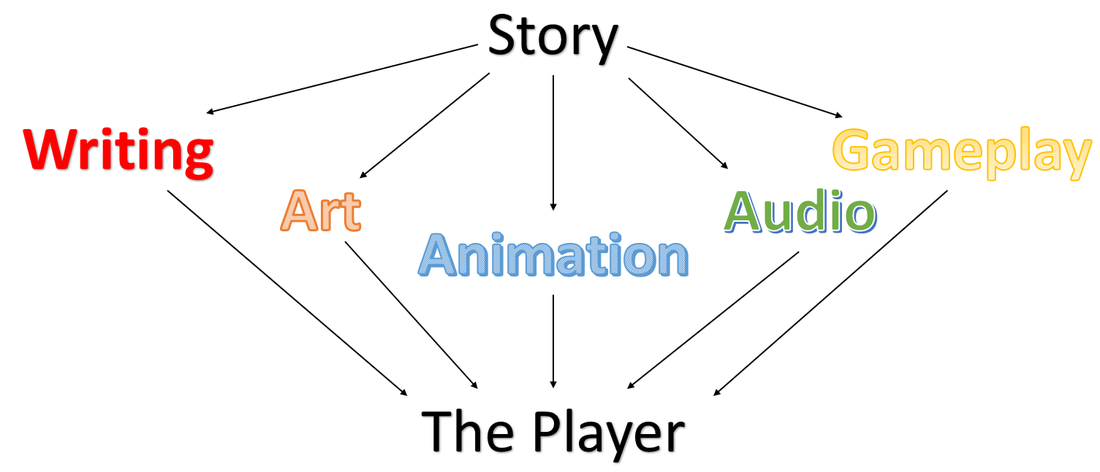
The story is actually an idea - what's happening and why is it happening? - not just a sequence of things that people say. The story is an idea, and writing isn't the only tool we can use to convey an idea. The script will convey some of that idea, but in a well designed game the script doesn't convey all of it. A script that tries to convey the entire story becomes a book.
Ideally, writing is used to tell one part of the story, but other assets and aspects of the game's design should tell other parts. As just one example, the environment art can indicate what happened in an area before the player arrived. Take a look at this screenshot from Limbo:
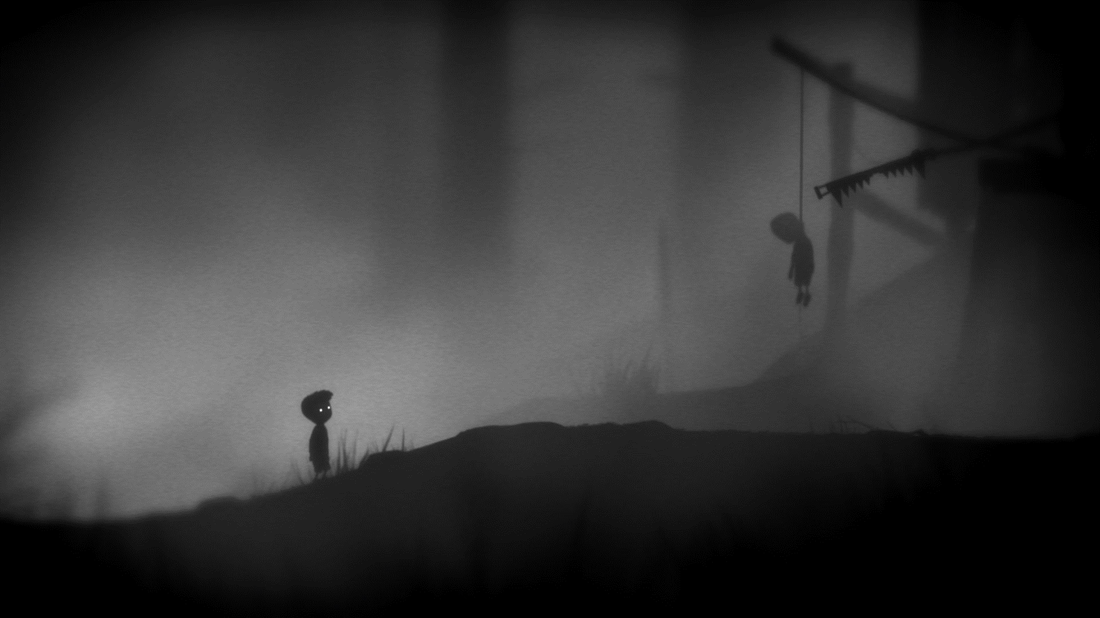
There isn't any writing here to indicate what happened, but we don't really need it. And that's the key point I want to make: once an element of the story has been communicated through any aspect of the game, be it the gameplay, the environment art, the audio design, whatever, it no longer needs to be communicated through writing. The player will take pieces of the story from each, separate aspect of the game and will combine them together in their head to get the complete picture. Writing is a piece of that, but only a piece. Another example (warning - there's an F-bomb and plenty of violence):
This song in Far Cry 3 plays underneath the first mission in which Jason gets a flamethrower, and it helps to begin his character arc - a spiral into adrenaline addiction and violence. Beyond making the gameplay feel badass, the music gives you insight into Jason's mindset. When it is shown in the next cutscene that Jason enjoyed the flamethrower a little too much, we aren't surprised: the music began his transformation for us.
The most common piece of advice game writers get is to keep their writing short - the player wants to play the game, not watch a movie! - but that often presents another problem: minimal writing sometimes results in a thin story. They key to creating a compelling, full-bodied story while also keeping your cutscenes lean and mean is understanding when other aspects of the game should tell the story. If you can tell part of your story without writing, you should consider it - it'll make the world of your game richer and it'll allow you to do more with the writing you do need.
Tip #3: Writing Is A Form Of Feedback
The main weakness of writing in a video game is that writing is not interactive. Players can't play the game and read at the same time. Players can kind of listen to voice acting while playing the game, but only if the gameplay at that moment doesn't require a lot of concentration. In order for writing to be effective, the gameplay needs to take a step back.
Now, that doesn't mean writing is inherently toxic to compelling gameplay, but it does mean writers need to be careful of two different things: when their writing is presented to the player and how much writing is given to the player at once. Writing at the wrong moments breaks the flow of the gameplay, and too much writing at any one moment can drag the player away from the gameplay for too long.
The key to strategically placing writing in your game has to do with something called the "feedback loop".
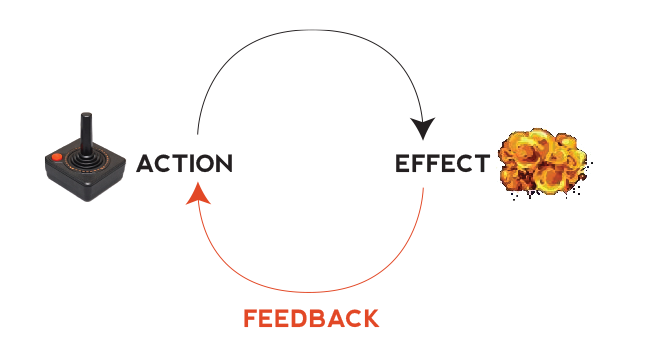
The feedback loop is a three part cycle that occurs when the player plays the game:
1. The payer takes an "action" - which, for video games, generally means they press a button.
2. That action has an "effect" in the game - because they pushed a button at the right time, their avatar character successfully attacked an enemy.
3. "Feedback" informs the player of the effects of their action - because the attack was successful, an animation plays that shows the enemy getting hurt. Once the player has been informed of the consequences of their prior action, they take another.
When writing the script for a game, it's best to think of your writing as a form of feedback - words do their best work when they're informing the player about the consequences of their actions. The player does something that has an effect on the game, whether it's progressing the story or putting them at odds with the local NPCs, and the writing informs them of how it affects the characters and the world. Good game writing doesn't push itself on players without cause - it happens in reaction to something the player does.
Often times, games will strategically place their cutscenes at the end of a level, after a boss fight or particularly difficult challenge. This pattern developed because it's a handy way of placing your writing in the game without disrupting the flow. A cutscene after a boss fight or other tough section acts as a reward, letting the player take a brief, well-deserved rest while you entertain them. Writing is still entertainment after all, it just isn't interactive entertainment, which means that it can give the player a break without boring them.
The idea is that placing writing in response to the player's victories keeps it from disrupting the flow of the game, and ensuring that multiple assets are telling the story (tip #2) ensures your scenes don't drag on too long.
Writing can be used creatively - it doesn't only have to happen at the tail end of a level - but writing should never interrupt the player when they're in the middle of something, and it should never occur out of nowhere. Writing should be used after the player has performed a specific task, after they've successfully accomplished one of their "verbs", to let them know how their play has affected the world of the game.
Tip #4: Focus On Environments, Not Sequences
My other three tips are all leading up to this one concept. This is what I wish I had known most when I first started writing for games: video game stories - unlike stories in every other storytelling medium - are not inherently a sequence of events.
A book is a sequence of words that's the exact same every time it's read, a movie is a sequence of images and sounds that's the same every time it's watched, but a video game isn't necessarily a sequence of anything - it's an environment, and inside that environment the player can do whatever they want as long as they abide by the rules of the game.
Video games are the only storytelling medium in which the writer doesn't directly control what happens next. The player decides what happens next, and the writer reacts to the player.
This means that, while a game can include a specific plot, and while that can work very well, being a storyteller in games is about creating an environment - how does the world of the game (and I'm including the characters as a part of the world) react to the player's actions, and why does it react the way that it does?
Each game is different, but the tips I've laid out should hopefully provide a basic framework for understanding what I mean. The world of the game, which includes the writing, but also the gameplay mechanics, the environment art, the audio, etc. (Tip #2) reacts (Tip #3) to what the player does (Tip #1). Writing the story for a game generally involves writing a script, but it's more than that: it's creating a world that responds to the player in emotionally compelling ways.
Even when a game does have a plot, it's generally able to have it because of the way the environment was designed. The game is still reacting to what the player does, but it's able to react with a specific sequence of plot events because the environment made it possible. That's probably a little confusing, so let's jump right into an example.
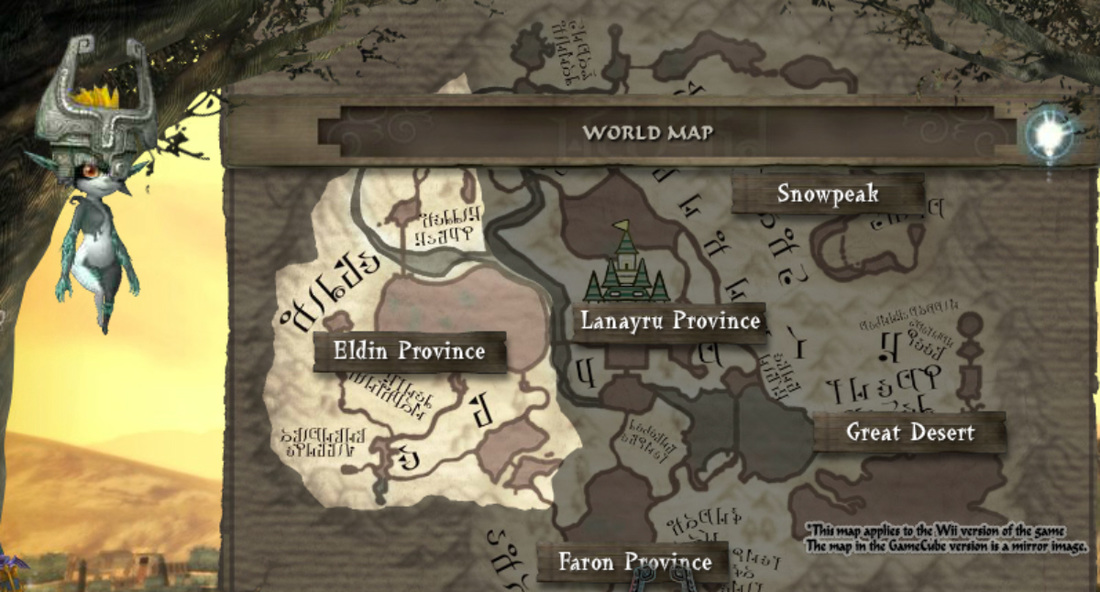
In The Legend of Zelda: Twilight Princess (and pretty much every Zelda game), there's a sequence of plot events that plays out identically every time you play the game, but the story is able to do that because of the environment. When you start, only one area of the game is available for exploration. Inside that environment you can do whatever you want - the player still decides what happens next - but the subsequent area is only unlocked when you complete a specific challenge. The game doesn't directly control what you do at any one point in time, but if you want to progress, you will eventually have to venture into a distinct dungeon and defeat the boss inside. Once the boss is defeated, the story reacts to your success with a plot event and the next area becomes accessible. The area after that is only unlocked once a new, equally specific boss is defeated, and so on and so forth.
The game never directly controls you, but the environment funnels you through a specific sequence of challenges, and so the story is able to react to your sequence of successes with a sequence of plot events. Games will sometimes have linear plots, but only when the game environment can funnel the player through it. For the record, there's nothing inherently inferior about linear games - there' a place for The Legend Of Zelda, Half Life, and Uncharted, but that's not the only option available to us.
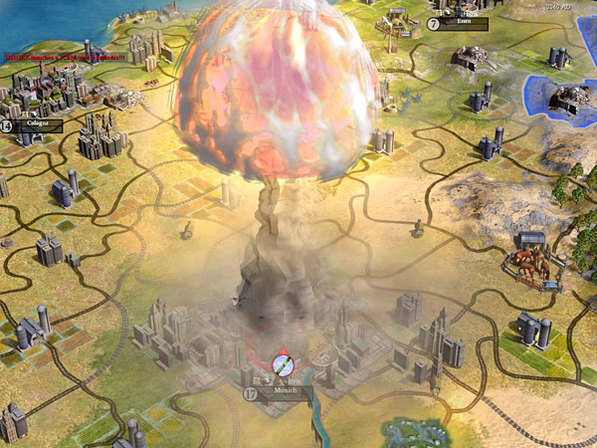
Civilization 5 is an example of something different - it has some great emergent storytelling, but it's all present in the way that the environment reacts to you, not because of a specific plot. If you have a small military, aggressive NPCs will attempt to bully you - but if you have the atom bomb, passive NPCs will fear you. Complicated diplomatic treaties can cut off resources from aggressive players, tourism can make a population incredibly unhappy, and certain countries will attempt to fight your influence in different ways, creating a unique emotional experience each time the game is played. The story plays out through gameplay mechanics, but it becomes a story because of the human context behind why everyone is behaving the way that they are. The story is in how the environment reacts to you and why it reacts the way that it does.
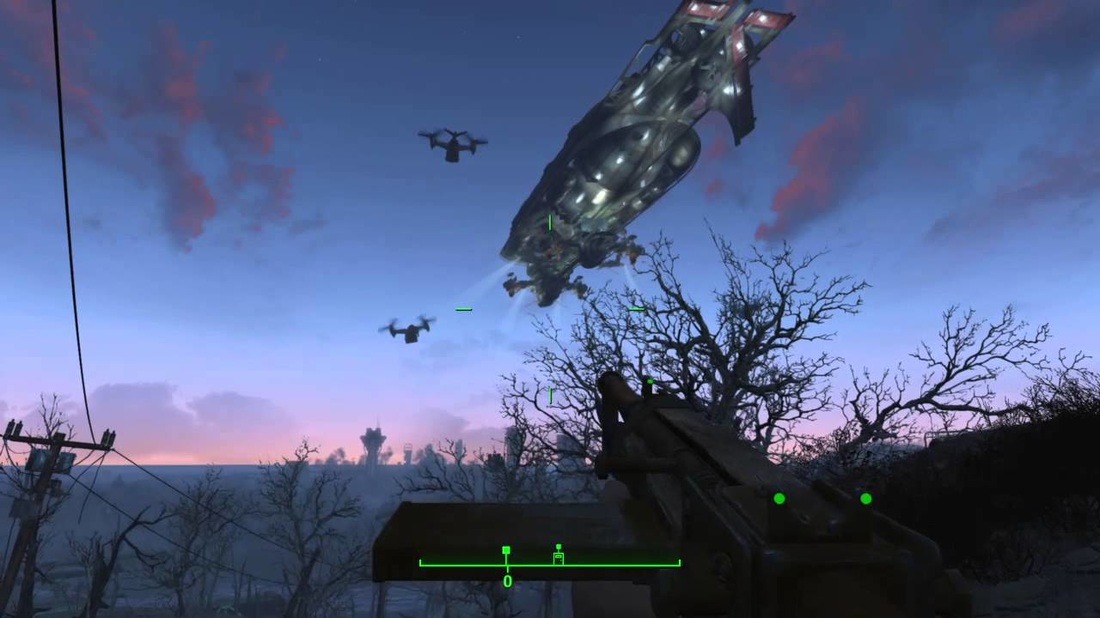
Fallout 4 has bits of both: it has an overarching plot, but the story is ever-present in the world and the way that it responds to you. Once you complete a specific plot event, The Brotherhood of Steel arrives in the Commonwealth and declares war on both The Institute and the local mutations. Brotherhood expeditions are sent out on missions (you'll randomly come across battles between Brotherhood soldiers and their enemies) and the Brotherhood members will react to you differently depending on which factions you've sided with. Meanwhile, the common citizen will speak to you differently depending on whether you've taken the Minutemen under your wing. Some citizens will open up to you if you've joined The Railroad - a secret organization that protects synthetic humans. Rumors of your deeds will spread throughout the commonwealth after you've completed specific quests, allowing some NPCs to recognize you on the street. The environment of the game (which includes the writing) reacts differently to you depending on how you play.
Most commercial games have plots, and it's important for a game writer to understand how a plot works, but not all games have plots and not all plots will be linear. Games will always have environments, however, and the environment shapes what the plot can be. Often times you can still have a plot in a non-linear environment, but it requires the use of unique plot structures that only exist in games - you can create branching stories like the Mass Effect games, you can create Modular stories where multiple, smaller plots come together to create an overarching plot, like 80 Days or Sunless Sea. You can even create games that tell emergent stories which the writers never wrote, like Civilization 5 or Plague Inc., but attempting to push a linear, sequential plot into a non-linear environment doesn't work. Start with the game's environment and work from there.
This was a re-post of an article I wrote to promote a video game writing class I'm teaching. If you want to see the original article (virtually identical, except for some more information about the class) click here.
Read more about:
Featured BlogsAbout the Author(s)
You May Also Like







.jpeg?width=700&auto=webp&quality=80&disable=upscale)








